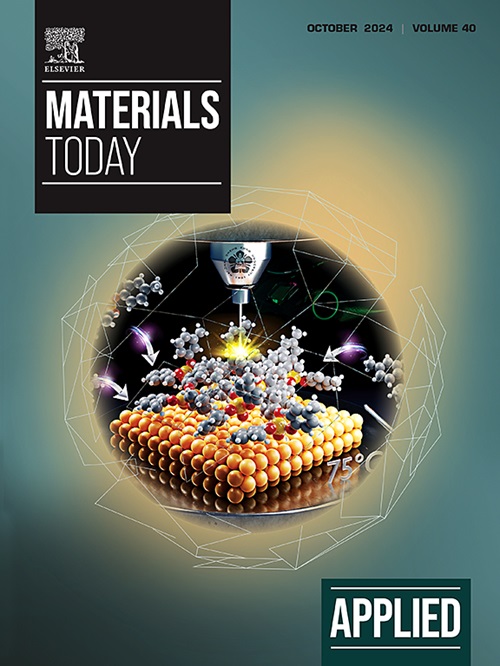Exploring robust microwave absorption properties of functional polyvinyl butyral (PVB) via facile cross-linking and data-driven material discovery
IF 6.9
2区 材料科学
Q1 MATERIALS SCIENCE, MULTIDISCIPLINARY
引用次数: 0
Abstract
This work introduces a chemically facile approach for synthesizing cross-linked polyvinyl butyral (XPVB) at room temperature, utilizing divinyl sulfone (DVS) as the cross-linking agent. Leveraging data-driven discovery methods, we optimize the DVS concentration to enhance the material's reflection loss (RL) performance, establishing XPVB as a formidable contender in microwave absorption without the need for conventional filler materials. Gaussian Process Regression (GPR) was used in this analysis, the material's development process was streamlined to achieve a high-fidelity predictive model that closely aligns with the observed experimental data. The synergy between our GPR model and the empirical evidence is particularly noteworthy, with the GPR predictions exhibiting exceptional agreement across the investigated frequency range, especially in the Ku-band, where high RL values are crucial. These findings indicate that XPVB exhibits exceptional dielectric properties that translate into an unprecedented absorption bandwidth encompassing the entire Ku-band, paired with strong RL, thereby achieving a significant attenuation of electromagnetic waves even at minimal material thicknesses. The optimized XPVB sample, without any filler addition, delivers an exceptional RL performance. Notably, a 2.4 mm-thick XPVB sample demonstrated an extraordinary RL value of -44 dB with RL≤-10 dB absorption Ku-bandwidth (12.4–18 GHz), showcasing the material's potential as a standalone absorber. This synthesis methodology, combined with the analytical approach, lays the groundwork for further research and development in microwave absorbers and has the potential to significantly impact the fields of defense, telecommunications and self-powered devices by providing a new standard for material performance.通过简易交联和数据驱动的材料发现,探索功能性聚乙烯醇缩丁醛 (PVB) 的强大微波吸收特性
这项工作介绍了一种利用二乙烯基砜(DVS)作为交联剂,在室温下合成交联聚乙烯醇缩丁醛(XPVB)的简便化学方法。利用数据驱动的发现方法,我们优化了 DVS 的浓度,从而提高了材料的反射损耗 (RL) 性能,使 XPVB 成为微波吸收领域的有力竞争者,而无需传统的填充材料。分析中使用了高斯过程回归 (GPR),简化了材料的开发过程,以实现与观察到的实验数据密切吻合的高保真预测模型。我们的 GPR 模型与经验证据之间的协同作用尤其值得注意,GPR 预测结果在整个调查频率范围内表现出卓越的一致性,尤其是在高 RL 值至关重要的 Ku 波段。这些研究结果表明,XPVB 具有优异的介电特性,可转化为前所未有的吸收带宽,涵盖整个 Ku 波段,同时具有很强的 RL,因此即使在材料厚度极小的情况下也能显著衰减电磁波。经过优化的 XPVB 样品不添加任何填料,具有卓越的 RL 性能。值得注意的是,2.4 毫米厚的 XPVB 样品显示出 -44 dB 的非凡 RL 值,RL≤-10 dB 吸收 Ku 带宽(12.4-18 GHz),展示了该材料作为独立吸收体的潜力。这种合成方法与分析方法相结合,为进一步研究和开发微波吸收器奠定了基础,并有可能通过提供材料性能的新标准,对国防、电信和自供电设备领域产生重大影响。
本文章由计算机程序翻译,如有差异,请以英文原文为准。
求助全文
约1分钟内获得全文
求助全文
来源期刊

Applied Materials Today
Materials Science-General Materials Science
CiteScore
14.90
自引率
3.60%
发文量
393
审稿时长
26 days
期刊介绍:
Journal Name: Applied Materials Today
Focus:
Multi-disciplinary, rapid-publication journal
Focused on cutting-edge applications of novel materials
Overview:
New materials discoveries have led to exciting fundamental breakthroughs.
Materials research is now moving towards the translation of these scientific properties and principles.
 求助内容:
求助内容: 应助结果提醒方式:
应助结果提醒方式:


